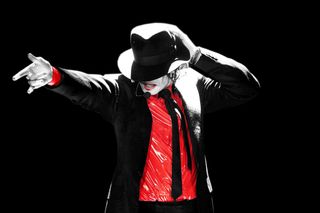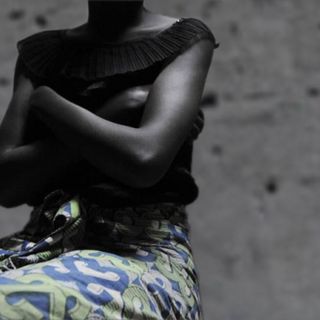
Salvaging the Michael Jackson Soundtrack of My Youth From the Predator Who Sang It
Whatever MJ was to become later, he was a child himself when he recorded “ABC.”

Michael Jackson’s music was, without a doubt, the soundtrack of my childhood. Long summer days were spent with “Thriller,” “Bad,” and the entire contents of those albums, on repeat. I would stare lovingly at the album art of Jackson lounging in a white suit with a tiger cub climbing all over him, strum along tunelessly on a plastic guitar to words I didn’t understand, dance so hard the record threatened to skip. The only possible rival he had in my life was Madonna, and luckily, I didn’t have to choose.
Though MJ and I drifted apart in my teens, the older I got, the more nostalgia pushed me towards the music of my youth once more. I renewed my relationship with 80s Jackson. There was just so much to love about the music from the then 20-something artist, and he became a fixture of the impromptu living room dance parties I would have with my daughter, now the same age as I was when I first got my taste of “Thriller,” and with a plastic guitar of her own.
And then, the documentary Leaving Neverland premiered. Wade Robson and James Safechuck, the two men accusing Jackson of abusing them when they were young boys, were suddenly everywhere in the media. I didn’t want to listen to them, but I felt compelled to.
And I had to reevaluate the music.
At first, I forgot about it, simply avoiding the question for as long as possible. But when Spotify threw “Man in the Mirror” into the rotation one day, I didn’t make it past the opening verse. Given the song was released in 1987, the year he first met both Safechuck and Robson, the words were too much. The earnestness was too much. The simple, bald hypocrisy was too much. I had long stopped watching movies made by Woody Allen and Roman Polanski. I had given up on Kevin Spacey, too. Finally, I thought, I was done with MJ.
But despite my efforts, as so often happens when you try to avoid something, Michael Jackson was suddenly everywhere – on the radio, at the restaurant, in my daughter’s school dance production.
And then one evening, he made it back into my living room too, when Spotify chose Jackson 5 for one of our dance parties, and my six-year-old immediately responded with a familiar glee.
“A-B-C,” sang 12-year-old MJ. “Easy as 1-2-3.”
I stopped, and I listened. Whatever Jackson was to become later, he was a child himself when he recorded that song, a child enduring hardships that he claimed were behind his obsession with childhood for the remainder of his life.
“Before you judge me,” he pleaded in “Childhood,” as an adult man, at age 36. “Try hard to love me. The painful youth I’ve had.”
I have been able to accept that the child star whose public story began at age 5 should not be held accountable for the wrongs of the man he was yet to become.
It was a horrific thought — a man from beyond the grave demanding we discount his behavior because of his own wounds. Jackson’s own pain can never be a justification for the pain he has inflicted. Much as he tried to make it all about him, it was not. It was about accuser after accuser who spoke up, and quite possibly, victim after victim who did not. With his entreaty, Jackson was trying to make us complicit in his abuse, perhaps for the second time over. The first time around, we helped by putting him on a pedestal so bright that we were blinded as he exploited his young victims. “What if the art allowed the artist to prey?” Heidi Stevens wrote for the Chicago Tribune in an essay on separating art from the problematic artists that sometimes produce it. “What if the art was, in effect, a weapon?… Jackson’s access to young fans and pliable parents was a direct result of his fame, which was a direct result of his art. His music brought children into his orbit…. If the allegations are true, their art was bait.”
Does the audience, the source of an artist’s power, have a responsibility to hold accountable the stars it creates? And having come up short before, does that mean we should reject the tainted body of work now, in its entirety?
But our memories can’t be wiped clean. And what else would we lose if we even tried? “I could, I suppose, declare that I won’t watch any more of his movies,” film critic A.O. Scott writes in The New York Times in a piece fittingly titled “My Woody Allen Problem.” “But I can hardly unwatch the ones I’ve seen…. And even if I could, by some feat of cinephilic sophistry, separate those movies from Mr. Allen’s life, I can’t possibly separate them from mine.”
It would likely be even harder with music, which research shows is a powerful key to accessing not just our memories but their associated emotions. It isn’t as though we have to buy a movie ticket or even press play. Sometimes the songs rise to the surface of our minds, unbidden, so deeply are they ingrained in our experience. Every restaurant, radio station and streaming platform pushes Michael Jackson at you – you have no choice but to listen. Avoidance really isn’t an option, so, isn’t it better to process the new meaning of that music, rather than leave it as a painful trigger only?
Related on The Swaddle:
Shame, Family Secrecy Lead to Mishandling of Child Sexual Abuse
Listening to Michael Jackson in 2019 requires us to bear witness to the damage he – and possibly his music – has done before it can bring joy once again.
The music and the tragedy must exist side by side. No star’s image should be more sacred than the truth. While I am not ‘there’ yet with adult Jackson, I have been able to accept that the child star whose public story began at age 5 should not be held accountable for the wrongs of the man he was yet to become.
And that is how I can reclaim my memories.
So, for the time being, while I will not be listening to “Man in the Mirror” just yet, I can dance to “ABC” with my daughter, as a way to hold onto the music that has given me hours of unbridled joy when I was young and Michael Jackson was still my King of Pop.
Madhumita Bhattacharyya is the author of the Reema Ray Mysteries and Murder at the Temple.
Related


Report: Sexual Violence as a Weapon of Conflict, Vigilanteism on the Rise Globally
